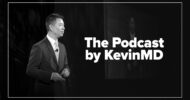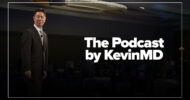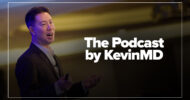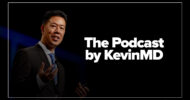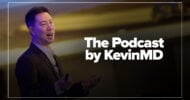Subscribe to The Podcast by KevinMD. Watch on YouTube. Catch up on old episodes!
We dive into the pain care crisis in the United States with Cindy Perlin, a social worker and chronic pain expert. We explore the epidemic of chronic pain, the limitations of conventional treatments, and the risks of opioid addiction. Cindy shares insights on alternative therapies, including mind-body approaches, nutritional medicine, and emerging technologies that offer hope for those suffering from chronic pain.
Cindy Perlin is a social worker.
She discusses the KevinMD article, “Why physicians need to become more educated about alternative pain treatments.”
Our presenting sponsor is DAX Copilot by Microsoft.
Do you spend more time on administrative tasks like clinical documentation than you do with patients? You’re not alone. Clinicians report spending up to two hours on administrative tasks for each hour of patient care. Microsoft is committed to helping clinicians restore the balance with DAX Copilot, an AI-powered, voice-enabled solution that automates clinical documentation and workflows.
70 percent of physicians who use DAX Copilot say it improves their work-life balance while reducing feelings of burnout and fatigue. Patients love it too! 93 percent of patients say their physician is more personable and conversational, and 75 percent of physicians say it improves patient experiences.
Help restore your work-life balance with DAX Copilot, your AI assistant for automated clinical documentation and workflows.
VISIT SPONSOR → https://aka.ms/kevinmd
SUBSCRIBE TO THE PODCAST → https://kevinmd.com/podcast
RECOMMENDED BY KEVINMD → https://kevinmd.com/recommended
GET CME FOR THIS EPISODE → https://kevinmd.com/cme
I’m partnering with Learner+ to offer clinicians access to an AI-powered reflective portfolio that rewards CME/CE credits from meaningful reflections. Find out more: https://kevinmd.com/learnerplus
Transcript
Kevin Pho: Hi and welcome to the show. Subscribe at KevinMD.com/podcast. We welcome back today, Cindy Perlin. She’s a social worker. Today’s KevinMD article is “Why Physicians Need to Become More Educated About Alternative Pain Treatments.” Cindy, welcome back to the show.
Cindy Perlin: Thank you.
Kevin Pho: So for those who didn’t listen to some of your prior episodes, let’s briefly share your story and journey again.
Cindy Perlin: OK, well, I’m 72 now, and when I was 25, I hurt my back running, and doctors didn’t seem to have any solutions. It got worse and worse until I ended up disabled for three and a half years, stumbling around and just happened to find a solution, which was biofeedback. Since that time, I’ve explored lots of different kinds of treatments. I tend to be someone who gets a lot of muscle aches and injuries, so everything that I’ve learned, I’ve been putting into a book. I wrote The Truth About Chronic Pain Treatments: The Best and Worst Strategies for Becoming Pain Free. I also have a website, the Alternative Pain Treatment Directory, at paintreatmentdirectory.com, which now has over 360 articles about alternative pain treatments.
Kevin Pho: All right, so this most recent KevinMD article, “Why Physicians Need to Become More Educated About Alternative Pain Treatments.” Before talking about that article, what led you to write this one in the first place?
Cindy Perlin: Well, just hearing from so many chronic pain patients that they weren’t getting help from their doctors. They were only being offered medications that weren’t working or surgical procedures that didn’t help or that they didn’t want to do. There’s just so much more out there. One of my biggest frustrations and disappointments was that when I was going through my own episode of chronic pain, I saw an orthopedic surgeon who seemed very compassionate and kind, and he spent a lot of time with me. But at the end, he said he didn’t know what was wrong with me, couldn’t help me, and told me to go on with my life as best I could. I had no life at that point. Years later, when I had recovered and was helping other people, I contacted him and said, “I appreciated your kindness, but you couldn’t help me. I’ve discovered things that do help people. Will you meet with me so I can talk to you about it?” He refused to talk to me, and that was very disappointing. I know I wasn’t the only person in that situation he ever saw.
Kevin Pho: You wrote in your article that chronic pain affects up to 56 percent of Americans and high-impact pain disables about 7 percent. Among the chronic pain community, do you think this is a typical experience regarding the medical profession not adequately addressing pain?
Cindy Perlin: Yes. There was even a survey of physicians at academic medical centers a few years ago, and 66 percent of the physicians who responded said they didn’t feel competent treating pain. That tells me it’s not just one-sided. I think physicians are terrified because they know if they prescribe opioids, the DEA can come after them. They’ve been told that opioids are the most effective tool they have. I don’t believe that, but it’s the tool they feel they have, and they’re afraid to use it. So, when they see a pain patient come in the door, they’re very uncomfortable. Patients pick up on that, and they don’t feel heard or welcome. If a patient loses their physician due to retirement, moving, or, in some cases, the physician losing their license, they struggle to find another doctor willing to treat them because physicians don’t want to handle pain patients.
Kevin Pho: What is the perspective from the chronic pain community regarding the potential DEA overreach that prevents many physicians from comfortably prescribing opioids?
Cindy Perlin: Many patients are very upset about that, and many have been harmed by being abruptly cut off or tapered off their opioids. They’re suffering and often not offered alternatives. What you generally see in patient advocacy is “give me my opioids back,” which is unfortunate because there are better solutions. Opioids have many issues besides addiction. They increase the risk of falls in the elderly and contribute to traffic accidents. If prescribed for acute pain, opioids can make it more likely to develop chronic pain. They also have side effects that impact quality of life, such as sedation and reduced activity levels. I hope to educate patients and physicians so that there is less suffering on both sides.
Kevin Pho: Let’s discuss some of these alternative pain treatments. What are examples of these treatments?
Cindy Perlin: There are natural pain relief methods, with the biggest probably being an anti-inflammatory diet without processed foods, as processed foods contribute to widespread pain and nutritional deficiencies, particularly vitamin D and magnesium. Sedentary lifestyles also play a role. The most overlooked aspect, in my opinion, is the mind-body connection. People who are chronically stressed or have a history of trauma often have an over-aroused nervous system, contributing to pain and inflammation in various ways. Many people I’ve met spent years trying different conventional and alternative treatments without success until they addressed their mental state.
Kevin Pho: When you talk about mind-body connection and anti-inflammatory diets, what are some specific modalities they can use?
Cindy Perlin: There’s a great book, The Body Keeps the Score, which discusses how trauma changes the brain and how talk therapy often can’t access those changes. Treatments that work include neurofeedback, a type of brain activity biofeedback, and EMDR (eye movement desensitization and reprocessing), a nonverbal treatment involving eye movements to create new brain connections. Another is energy psychology, with the most well-known being the Emotional Freedom Technique, or tapping. This therapy helps release stuck energy from the body’s trauma response.
Cindy Perlin: Tapping can help clear the energy associated with trauma and relieve PTSD symptoms, such as flashbacks. Many people think they haven’t experienced trauma, but there is also what’s called “small T trauma,” which includes growing up in a home where you don’t feel safe, are criticized, or don’t feel loved. These daily psychic insults can affect people physiologically as much as a significant trauma like sexual abuse, physical abuse, or experiencing a natural disaster.
Releasing chronic muscle tension and over-arousal from the body can be very beneficial. Central sensitization is another condition to consider, where the brain becomes stuck in a loop, continually sending pain signals even after tissues have healed. Two treatments that can help with this are neurofeedback, as I mentioned earlier, and CalMARE therapy, which isn’t widely available. CalMARE sends a “no pain” signal to the brain, effectively resetting it after about 10 sessions over two weeks. The brain stops sending pain signals. For musculoskeletal pain, treatments like acupuncture, physical therapy, and massage can be helpful.
Kevin Pho: The biggest challenge with accessing these alternative pain treatments is that insurance often doesn’t cover them. Is that correct?
Cindy Perlin: Yes, that’s the main issue. Many of these therapies aren’t covered by insurance, which limits access, especially for those financially constrained or on long-term disability. That’s why it’s essential to reach people early, before they’ve gone too far down the path of chronic pain and disability.
Kevin Pho: If a physician wanted to recommend these alternative treatments, where can they direct patients to learn more or find resources?
Cindy Perlin: That’s why I created my website, paintreatmentdirectory.com. Patients and physicians can search by condition or treatment, read articles, and find products. Some of the most promising interventions involve devices that use electrical stimulation, light, or magnetic pulses. There are home treatment devices that are relatively inexpensive and allow people to treat themselves. For instance, light therapy, also known as photobiomodulation or low-level laser therapy, enhances healing by making cells more permeable, allowing nutrients and oxygen to enter and boosting ATP production, the cell’s energy source.
Kevin Pho: Now, you’re more in touch with the chronic pain community. Are they generally interested in exploring alternative pain treatments? How open are they to these options listed in the Alternative Pain Treatment Directory?
Cindy Perlin: Most people are open to learning about these alternatives. However, there is a subset that is focused on “give me my opioids back,” which is partly due to the aggressive marketing by Purdue Pharma and the belief that opioids are the best option. But many people, when they learn about alternative treatments, are willing to try them. The biggest barrier remains financial, with a lack of insurance coverage being a significant issue. Chronic pain patients often face financial constraints, so it’s vital to intervene early to prevent them from becoming long-term disability cases.
Kevin Pho: For those considering alternative treatments, what are the costs like? Can you give an example of a typical expense for a common treatment?
Cindy Perlin: It’s hard to generalize, but an acupuncture or massage session might cost between $60 and $100 per visit, and people might go once a week. The good news is these treatments are time-limited; you hopefully recover and don’t need ongoing sessions forever, unlike taking opioids, which some people use for life. A healthy diet is another expense, as fresh, organic foods are more costly than processed foods. Personally, I spend around $200 a month on supplements like magnesium, vitamin D, herbal supplements, and omega-3 fatty acids. The most crucial supplement I recommend is vitamin D, which is very inexpensive at about $10 a month. Many people are vitamin D deficient, and it supports over 400 processes in the body, including helping to alleviate chronic pain.
Kevin Pho: Are certain types of pain more receptive to alternative treatments? For example, is there a difference between musculoskeletal and neuropathic pain in how well they respond?
Cindy Perlin: It really depends on matching the treatment to the condition. Most types of pain can benefit from alternative therapies, but some conditions are more intractable. For instance, complex regional pain syndrome (CRPS) is a severe condition that conventional medicine struggles to treat. However, CalMARE therapy can be very effective for CRPS, with most people experiencing significant pain reduction after 10 sessions. On the other hand, musculoskeletal pain might respond better to treatments that address muscle imbalances, chronic tension, and therapies like light or magnetic therapy. It’s important to match the right treatment to the right condition.
I offer 90-minute virtual pain consults where I review a person’s condition, treatment history, and make personalized recommendations on which treatments are most suitable.
Kevin Pho: We’re talking to Cindy Perlin, a social worker. Today’s KevinMD article is “Why Physicians Need to Become More Educated About Alternative Pain Treatments.” Cindy, as always, we’ll end with some take-home messages for the KevinMD audience.
Cindy Perlin: Thank you, Kevin. One thing I’d like to emphasize is that I’m open to consulting with physicians on individual cases. I urge doctors to keep an open mind and get educated about alternative treatments. A referral to an effective alternative treatment can be as valuable as a prescription and doesn’t take much extra time.
Kevin Pho: Cindy, as always, thank you so much for sharing your perspective and insight, and thanks again for coming back on the show.
Cindy Perlin: Thank you for having me.









